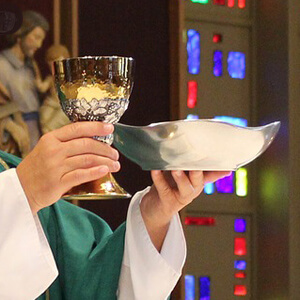
Although I don’t have at this moment the exact earliest instance the Church started teaching that both species (host and chalice) each contains the fullness of Jesus Christ’s glorified body, blood, soul and divinity, I can tell you that St. Thomas Aquinas (13th century) has already affirmed it in his Summa Theologiae, 3rd part question 76. And the last time the Church declared the same teaching in a council was at the Council of Trent. So I can assure you that this is not a new teaching.
The reason why this is necessary because the Church believe not so much that Jesus’ Body and Blood are individually present in the Sacrament, but that Jesus Himself in His entirety is present in the Blessed Sacrament — not only in the Blessed Sacrament in general, but in each and every part of it; namely, the Church believes that Jesus is fully present in even the smallest piece of host, or the smallest drop of the chalice.
And since Jesus is fully man and fully God, His full Body, Blood, Soul and Divinity is present in each particle of host and each drop of the chalice.
When Jesus said “This is my body, take and eat” and “This is my blood”, we have to remember that He was instituting a sacrament, and not explaining theology in exclusive terms. He was just simply stating the symbolism of bread and wine now points to His real presence, with the language of sacrament and devotion necessarily needs to be succinct and simple. If Jesus were to explain the intricacies of transubstantiation, then His disciples would have never understood the message.
Additionally, when Jesus first instituted the Eucharist, the Bread and Blood were never meant to be received separately. Jesus after all was celebrating the Passover meal, where both bread and wine have to be consumed. The separation of Body and Blood in association with bread and wine therefore was only separation in the symbolism of bread and wine due to its limitation in being each easily recognizable as both Body and Blood, but not in actuality points to a separation of Jesus into Body and Blood, which would mean neither species is the whole Jesus.
And if bread becomes only Body and chalice only Blood, then neither is Jesus, since just the Body or just the Blood is dead. But what we receive, even in one species or in the smallest quantity is the living, glorified Jesus in entirety, which necessarily consists of His Body, Blood, Soul and Divinity.
People in the early Church always received both species. To this day, in the Eastern rites and the Orthodox Church, the Bread is immersed in the wine and the whole cup of bread and wine are consecrated together. The faithful would then receive both from the priest through a special spoon.
In the Western Church, since its custom was to separate the symbolism into hosts and chalice since the beginning, when the administering of the chalice became increasingly difficult and was withheld from the faithful, the reception of only the host became the general practice for many centuries. But during the liturgical reforms of the early 20th century, culminating at the 2nd Vatican Council, the desire of the Council Fathers was to once again reintroduce the chalice so that the full symbolism of bread and wine may be once again reconnected to our belief in the Eucharist being the Real Presence. In other words, the chalice was brought back not because there is anything lacking in the Eucharist in the host — each host is the whole Jesus, but that we can have the full benefit of the symbolism of bread and wine both being the Body and Blood and Christ.
Having said that, Vatican II also clearly said that the chalice should be given at special occasions with proper catechesis. It was not originally meant to be made available at every mass, since there remains certain practical difficulties when it is offered daily that may not lead to due reverence without proper preparation, like too much left over, purification of the vessels, spillage, sacramental abuse and sanitary concerns.


